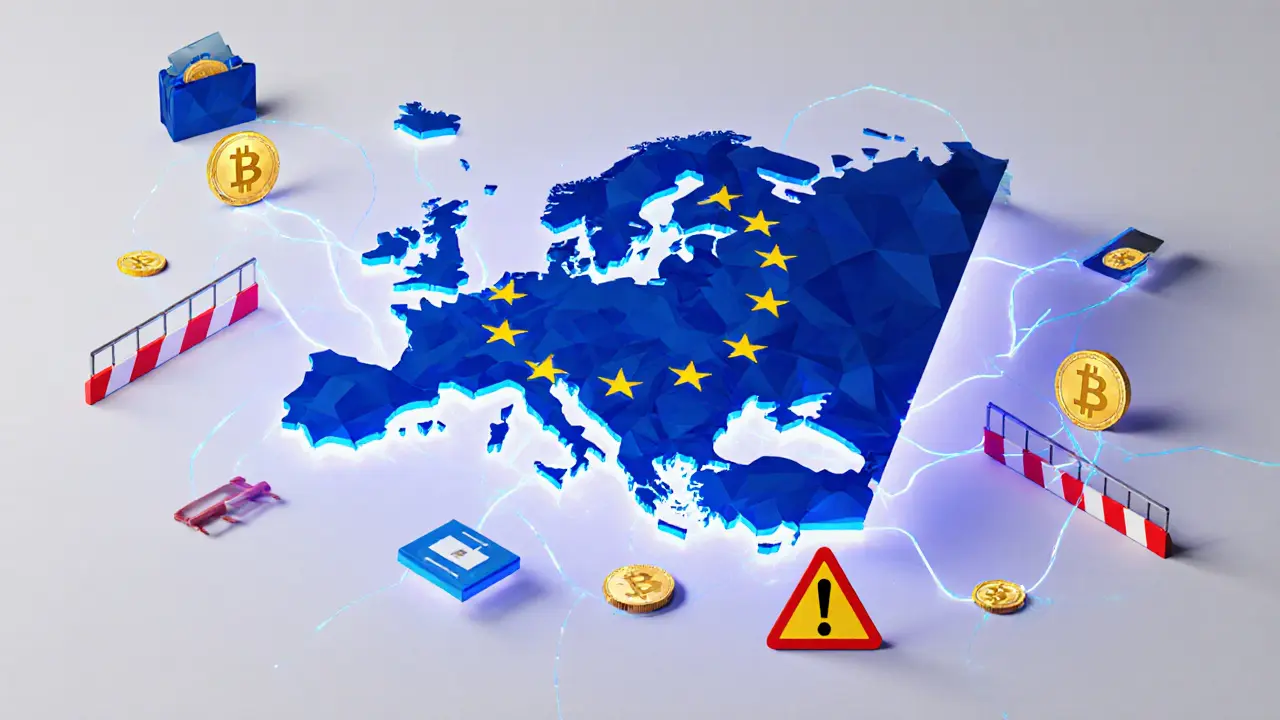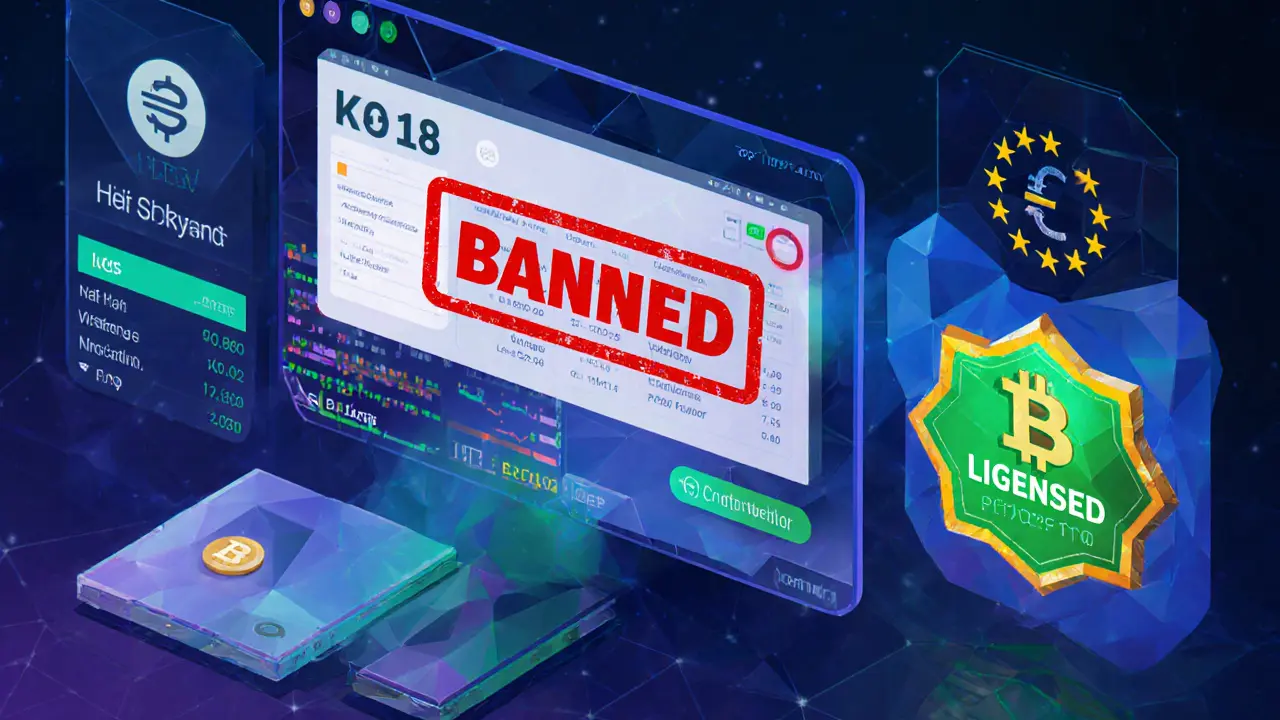EU Sanctions and Cryptocurrency Compliance: What You Need to Know in 2025
 Nov, 8 2025
Nov, 8 2025
Starting December 30, 2024, if you’re running a crypto business in the EU-or even just sending crypto to someone there-you’re under new rules. No more gray areas. No more excuses. The European Union’s MiCA regulation is now fully in force, and it’s changing everything about how crypto moves, who can touch it, and what happens if you break the rules.
What MiCA Actually Means for Crypto Businesses
MiCA isn’t just another guideline. It’s a full legal framework that treats crypto asset service providers (CASPs) like banks. If you’re offering trading, custody, or issuance services in the EU, you need a license. No exceptions. The European Securities and Markets Authority (ESMA) is the main enforcer, but each EU country has its own national authority too. And here’s the kicker: once you’re licensed in one country, you can operate across the whole bloc. But if you’re caught violating the rules, you’re banned from all 27 countries. The regulation doesn’t just care about your business model-it cares about your tech. You need systems that can trace every transaction from sender to recipient. That’s not optional. It’s required by the Transfer of Funds Regulation (TFR), which runs hand-in-hand with MiCA. If you’re sending €1,000 or more in crypto, you must collect and share the full names, addresses, and wallet IDs of both parties. No anonymous transfers. No mixing services. No privacy coins bypassing the system.Stablecoins Are Under the Microscope
If you think stablecoins are just “safe crypto,” think again. The EU treats them like digital cash-and they’re regulated like it. Any stablecoin issuer wants to operate in the EU must prove they hold 1:1 reserves in liquid assets. That means real euros, not vague promises. They also can’t process more than €200 million per day without explicit approval from the European Central Bank. And yes, they need to report every single transaction to national authorities. This isn’t about stopping innovation. It’s about stopping fraud. In 2024, over €1.2 billion in crypto was laundered through unregulated stablecoin bridges targeting EU users. MiCA shuts that down. Issuers now face daily audits. Failure to maintain reserves? Fines up to 5% of global turnover. Repeat offense? License revoked. Permanent ban.The Hidden Rules: DORA and CARF
MiCA isn’t alone. Two other regulations are quietly tightening the screws. First, the Digital Operational Resilience Act (DORA). It kicked in on January 17, 2025. If your crypto platform has any digital infrastructure-cloud servers, APIs, wallet systems-you must now pass regular cyber resilience tests. You need backups that work. You need third-party vendor oversight. You need incident response plans that are tested every quarter. Miss a test? You’re flagged. Fail twice? You’re suspended. Then there’s CARF-the Crypto-Asset Reporting Framework. It’s not active yet, but it’s coming fast. By 2026, every CASP must report user tax data to national tax authorities. That means names, wallet addresses, transaction volumes, and capital gains. The EU is building a real-time tax tracker for crypto. No more hiding earnings. No more offshore wallets. This is the final piece of the puzzle.
What Happens If You Don’t Comply?
The EU doesn’t warn twice. If you’re operating without a license after December 30, 2024, you’re already in violation. The penalties aren’t theoretical-they’re being applied right now. - Fines: Up to 5% of your global annual turnover. For a mid-sized exchange, that’s millions. - Shutdown: National authorities can freeze your assets and shut down your platform immediately. - Blacklisting: Your company name gets added to a public EU sanctions list. No bank will touch you. No payment processor will work with you. - Personal liability: Company directors can be held personally responsible for AML failures. That means fines, travel bans, even criminal charges in extreme cases. In 2025, the EU shut down three major crypto exchanges based outside the bloc for failing to comply with TFR data-sharing rules. One of them had over 2 million users. They didn’t get a second chance.Grandfathering Isn’t a Free Pass
You might have heard that existing crypto firms had a grace period. That’s true-but only partially. The EU allowed up to 18 months to apply for licenses. But that’s not a guarantee. Some countries, like Germany and France, gave only six months. Others, like Malta, offered the full 18. The inconsistency creates chaos. And here’s the trap: during the transition, you’re still bound by old AML rules. If you’re flagged for suspicious activity during this time, you can still be fined-even if you’re waiting for your MiCA license. Many firms thought they had time to fix things. They didn’t. By mid-2025, over 40% of unlicensed CASPs had already been investigated.
EU vs. US: Two Very Different Paths
While the EU is building a wall around crypto, the US is trying to build a bridge. In July 2025, the U.S. passed the GENIUS Act, which lets stablecoin issuers operate under a federal licensing system with more flexibility. The SEC’s approach is “regulate as you go.” The EU’s is “regulate before you launch.” The difference isn’t just policy-it’s philosophy. The EU sees crypto as a threat to monetary sovereignty. The U.S. sees it as an opportunity to lead. That’s why the ECB is pushing hard for a digital euro. They don’t want Bitcoin or Ethereum replacing the euro. They want a state-backed digital currency that’s fully traceable, fully controlled, and fully compliant. For businesses, this means a split market. If you want to serve EU customers, you play by EU rules. If you want to serve U.S. customers, you play by U.S. rules. There’s no middle ground. Trying to do both without separate legal entities? That’s how you get fined, shut down, and blacklisted.What Should You Do Now?
If you’re a crypto business:- Check if you’re licensed under MiCA. If not, apply immediately. The window is closing.
- Upgrade your transaction monitoring tools. You need real-time KYT (Know Your Transaction) systems that flag sanctioned wallets.
- Map out your data flow. Every sender and recipient must be verified. No exceptions.
- Train your team. AML compliance isn’t a one-time task. It’s a daily discipline.
- Don’t rely on third-party vendors unless they’re MiCA-certified. You’re liable for their failures.
- Use only licensed platforms. Look for the MiCA license badge on their website.
- Avoid mixing services or privacy coins like Monero or Zcash. They’re effectively banned from EU-facing services.
- Keep records. CARF is coming. You’ll need proof of transactions for taxes.
- Don’t assume anonymity. If you send crypto to an EU wallet, your identity may already be recorded.
The Bigger Picture
The EU isn’t just regulating crypto. It’s redefining financial sovereignty. By tying sanctions, tax reporting, and operational resilience into one framework, they’ve created the most tightly controlled digital finance system in the world. Other countries-Canada, Japan, Singapore-are watching closely. Many are copying the EU model. This isn’t about stopping crypto. It’s about controlling it. The EU wants innovation-but only on their terms. And if you’re not ready for that, you won’t survive in Europe.Do EU sanctions on crypto apply to individuals?
Yes, but indirectly. Individuals aren’t required to get licenses, but if you use an unlicensed exchange or send crypto to a sanctioned wallet, you risk having your transactions blocked or frozen. Your bank or payment provider may also report you to authorities if they detect suspicious activity. While you won’t be fined directly under MiCA, you can still be investigated for AML violations.
Can I still use Bitcoin in the EU?
Yes, but only through licensed platforms. Bitcoin itself isn’t banned. But if you’re using a wallet or exchange that doesn’t comply with MiCA and TFR, your transactions may be blocked. Many exchanges have already delisted privacy coins and restricted access to certain wallets flagged by EU sanctions lists.
What happens if I send crypto to someone in the EU without sharing my info?
The transaction will likely fail. Under TFR, CASPs must verify both sender and recipient data for transfers over €1,000. If you’re using a non-compliant wallet or peer-to-peer platform, the receiving exchange or custodian will reject the deposit. Your funds may be held indefinitely until identity verification is completed-or returned to sender.
Are NFTs regulated under MiCA?
Most NFTs are exempt unless they function like financial instruments-like fractionalized ownership tokens or those with profit-sharing rights. Pure collectible NFTs (art, gaming items) aren’t covered. But if you’re trading NFTs as investments or using them for fundraising, you may fall under MiCA’s scope and need a license.
Is the digital euro going to replace crypto in the EU?
Not replace-but limit. The ECB sees the digital euro as a public alternative to private crypto. It will be fully traceable, instantly settled, and backed by the EU. Over time, it’s expected to dominate everyday payments, pushing crypto into niche roles like cross-border remittances or speculative trading. Crypto won’t disappear, but its use in daily life will shrink.
How do I know if a crypto platform is MiCA-compliant?
Look for the official license number issued by a national authority (like BaFin in Germany or AMF in France). Reputable platforms display this on their website’s footer or legal page. You can also check ESMA’s public register of licensed CASPs. If they don’t show it, assume they’re not compliant.


Evan Koehne
November 9, 2025 AT 17:47Chloe Walsh
November 11, 2025 AT 08:24Anthony Allen
November 12, 2025 AT 04:40karan thakur
November 13, 2025 AT 11:36Vipul dhingra
November 14, 2025 AT 04:25Stephanie Tolson
November 14, 2025 AT 10:31Megan Peeples
November 15, 2025 AT 17:48Becca Robins
November 16, 2025 AT 01:03Arjun Ullas
November 16, 2025 AT 13:05Robert Bailey
November 18, 2025 AT 01:21Alexa Huffman
November 18, 2025 AT 13:23Meagan Wristen
November 20, 2025 AT 05:25Jessica Arnold
November 20, 2025 AT 06:30